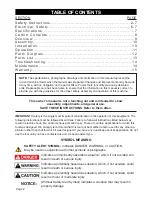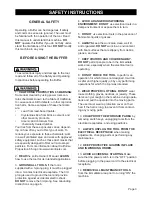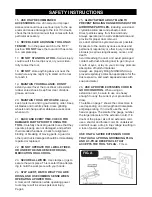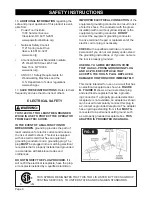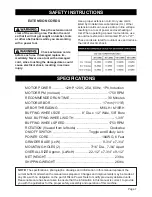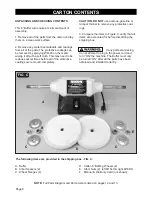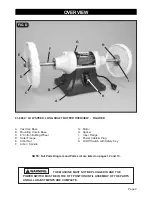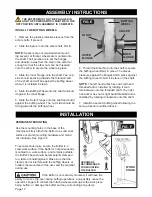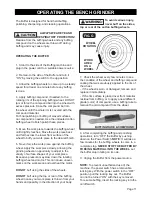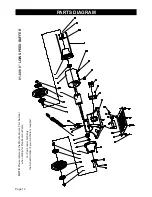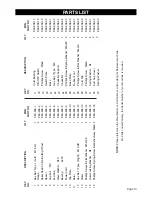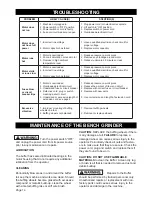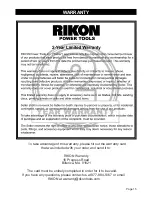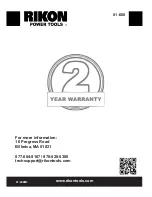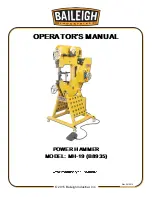
SAFETY INSTRUCTIONS
SPECIFIC SAFETY
INSTRUCTIONS FOR BUFFERS
Basic precautions should always be followed
when using your buffing machine. To reduce the
risk of injury, electrical shock, or fire, comply with
the safety rules listed below:
1.
ALWAYS WEAR EYE PROTECTION.
Everyday eyeglasses are
NOT
safety glasses.
ALWAYS
wear Safety Goggles (that comply with
ANSI standard Z87.1) when operating power
tools. The operation of any buffer or power tool
can result in debris being thrown into your eyes,
which can result in severe and permanent eye
damage.
2.
ALWAYS WEAR RESPIRATORY PROTEC-
TION.
Exposure to fine dust and buffing debris
particles can be hazardous to your health. Al
-
ways wear a NIOSH-approved respirator or dust
mask to reduce your risk of respiratory damage.
3.
SECURE THE BUFFER
to a stand or work
-
bench to prevent sliding or tipping during use.
See page 10.
4.
WEAR TIGHT FITTING GLOVES
when buff-
ing as the work pieces can get hot or have sharp
edges. Gloves should be tight so they will not get
caught in the buffing wheel. Leather gloves are
recommended.
5.
INSPECT THE WORK PIECE
before buffing
to insure that there are no loose parts, knots,
splinters or sharp and potentially dangerous
shaped areas that may catch and thrown at the
operator.
6.
NEVER BUFF SMALL WORK PIECES
with-
out them being properly held by pliers or clamps,
or they will be ripped out of your hands and
possibly cause harm to you or damage the item.
7.
NEVER PUT FINGERS INSIDE WORK
PIECES
to hold them when buffing. Should the
object being buffed be caught and thrown by the
wheel, damage to your fingers may result.
8.
DO NOT STAND IN FRONT OF THE BUF-
FER WHEN STARTING IT.
Stand to one side of
the Buffing and turn it “ON”. Wait at the side for
one minute until the machine comes up to full
speed. There is always a possibility that debris
from a glazed or damaged buffing wheel may be
discharged towards the operator.
9.
ALLOW THE BUFFER TO ATTAIN FULL
SPEED BEFORE BEGINNING WORK.
Hold the
work piece securely, and slowly ease the work into
the buffing wheel. Be careful of any sharp edges
or corners that may catch on the wheel and be
torn from your hands.
10.
DO NOT
buff using the sides or the rear of
the buffing wheels. Buff only on the wheel slightly
below the wheel center.
11.
NEVER STOP THE BUFFER BY FORCING
MATERIAL INTO THE WHEEL.
Let the buffer
stop rotating on its own.
12.
RESURFACE / DRESS THE BUFFING
WHEEL OFTEN.
This will keep the wheel surface
free of residue and glaze. Use a metal rake or stiff
wire brush.
13.
THE DIAMETER OF THE BUFFING
WHEELS WILL DECREASE WITH USE.
Replace
the buffing wheels when they become too small
for effective buffing, to avoid any damage should
the sewn or bonded material break apart.
14.
REPLACE A DAMAGED BUFFING WHEEL
IMMEDIATELY.
A damaged wheel can discharge
debris at a high velocity towards the operator.
Tighten the spindle nut just enough to hold the
buffing wheel firmly on the arbor.
DO NOT
over-
tighten the nut. Only use the wheel flanges provid
-
ed with the grinder. When selecting a replacement
buffing wheel, use only properly sized wheels, and
verify that the wheel has a higher R.P.M. rating
than the maximum R.P.M. of the Buffer.
15.
FREQUENTLY
clean buffing debris and dust
from beneath and around the machine. Keep the
work area clean.
Page 5


